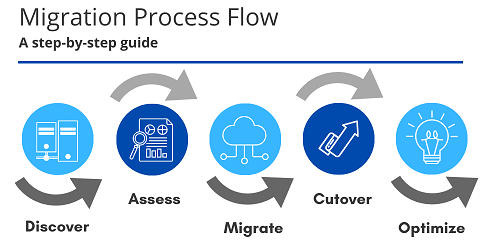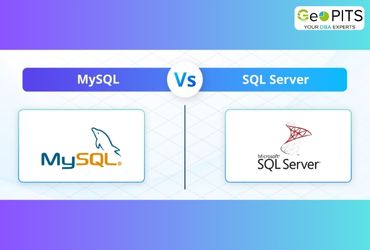Are you planning to move your enterprise database to the cloud? Traditionally organizations were storing their enterprise data on disparate systems on-premise. Increased digitization, especially since the pandemic, has brought about a huge change in the way organizations are handling and storing data. Database solutions are needed that are flexible, reliable, and secure. Most organizations are adopting cloud database platform services such as Amazon Web Services (AWS), Oracle DB, IBM DB2, Google Cloud, or Microsoft Azure.
What is a cloud database and how do you want to run your database in the cloud?
A cloud database is basically a type of database service built, deployed, accessed, and delivered through a private, public, or hybrid cloud computing platform.
- Public Cloud - This is a type of computing in which resources are highly scalable and provided to the public by the service provider via the internet. These resources can be storage capabilities, applications, or virtual machines. For example, third-party vendors such as Amazon Web Services (AWS) or Microsoft Azure own and maintain compute resources that customers can access via the internet.
- Private Cloud - It delivers the same advantages as the public cloud, including scalability and self-service, but is used to meet the requirements of a single organization. The organization uses a proprietary architecture and runs it on its own premises. Private clouds are for organizations that are very particular about their security or regulatory concerns related to using a multi-vendor environment. Some of the vendors are IBM, Microsoft, Dell, HPE.
- Hybrid Cloud - A cloud computing model that is a mix of Public and Private cloud computing services with proprietary software helping communication between each service. Hybrid cloud gives businesses the distinct advantages of both cloud solutions wherein the organization can store sensitive information on the private cloud and also leverage the computational resources of a managed public cloud. In addition, it can be used by organizations with dynamic workloads, a large mix of IT services, or large amounts of data to process.
How to Choose a Cloud Database?
According to IDG’s 2020 Cloud Computing research, 92% of an organization's IT environment is at least somewhat in the cloud today, as only 8% say their total IT environment is all on-premises.
A cloud database service is easy to use and offers many advantages. But different types of cloud databases offer different solutions. Cloud databases are delivered through a Traditional model, or via Database-as-a-Service (DBaaS).
- Database-as-a-Service (DBaaS) — Also known as managed database service, DBaaS is a cloud computing solution wherein the users can access and use a third-party cloud database system without buying and setting up their own infrastructure. The cloud vendor takes care of everything from database software, regular updates to backups, ensuring the security and availability of the database system 24/7. DBaaS delivers database functionality like Relational Database Management Systems (RDBMS) such as SQL Server, MySQL, and Oracle.
- Traditional Cloud Database Service — In traditional cloud services, management of data, and complete maintenance, is the responsibility of the in-house IT team. The database is installed and run on virtual machines in data centers, giving more control to the organization.
Cloud databases are here to stay and the top 5 databases in 2021 have been identified based on their features and popularity which can be considered while moving to the cloud.
Challenges of Migrating Database to the Cloud
Although migrating to the cloud has a number of advantages, it can be complex and risky for organizations that have always depended on in-house systems for years. Some of the common challenges enterprises face when considering cloud migration include:
Selecting the Right Data Storage Options
Choosing the right cloud storage is important, especially from performance, price, and security perspectives. Selecting the storage option that does not meet the criteria would likely hinder the operation of applications.
Security & Compliance
When moving to the cloud businesses need to change security and compliance approvals. They are required to apply for licenses that could be geographical or industry-based and comply with new standards.
Expert Resource Allocation
One of the major challenges is finding IT personnel who have the skills to ensure an effective migration. Currently, the demand for cloud experts is more than the supply.
Time of Migration
When it comes to migrating data to the cloud, organizations have to accurately determine the actual workloads to be moved and the order of migration. IT has to ensure that the migration does not disrupt existing processes such as enhancements and patches, or the workloads that manage these processes.
Underestimate or Overlook Costs
Cost of cloud migration that goes beyond the cost of data storage. Organizations need to understand all factors before making the move to the cloud. Cloud platforms are often cheaper than on-premises options, which require large upfront investments. Moreover, Cloud services follow a pay-as-you-go model or are billed once a month. However, you need to budget for any hidden costs, such as data transfer costs, and additional support and training.
Business Benefits of Cloud Databases
- Scalability - Cloud databases can be scaled quickly, efficiently, and are economical. As-needed basis, you can add and subtract server, power, and network capacity.
- Ease of Access - The cloud databases can be accessed by the users from anywhere, using a vendor’s API or web interface.
- Disaster recovery - In case of a natural disaster, power outage, or equipment crash, data is secure through backups on remote servers.
- Cost Saving - Easy access to the company's data can save time and money. Moreover, most cloud-computing services are pay as you go. Most vendors offer a unified pricing model across applications, infrastructure, and security.
Accelerating cloud adoption with GeoPITS
GeoPITS has end-to-end expertise in data migration offering that helps organizations to fast track their move to the cloud. Our cloud migration services use various native and third-party migration tools to get enterprise applications up and running on the cloud.
Our step by step process follows the below approach to accomplish the cloud migration seamlessly:

Discover & Assess - Evaluate what you’re migrating, what the data format looks like, where it resides, what should be the format post-migration, and how viable it is for cloud migration.
Design, Build and Convert - This also involves detailing the migration processes from designing the technical architecture, documenting the whole project, to set up a secure cloud environment based on workload requirements.
Data Migration & Validation - If you’re moving a large number of files, or you’re migrating sensitive information, you need to determine which data migration software will be used. Check if these tools can help validate, run and migrate applications into the cloud without rewriting them, modifying, or changing the processes.
Functional & Performance Test - Check if the right system permissions are in place to allow for successful data migration and all data migrating to the target from the source system is extracted. Closely monitor your data migration during the process, so that you can resolve any problems quickly as they arise.
Testing of the Final System - Once the migration is complete, final testing involves checking for any connectivity problems with source and target systems, ensuring all data migrated is correct, secure, and in the proper location. Conduct a full migration audit of the system and data quality. If there are any missing, incomplete, or corrupt data, restore these files from the backup.
Conclusion
The key to cloud migration is to recognize potential risks and obstacles at an earlier stage and create a seamless action plan to manage them. With careful planning and evaluation, you can easily navigate the complexities of migrating to the cloud and benefit from cloud-based IT operations.
Further reading:
If you found this article helpful, you might want to check out these related resources,




.jpg)


